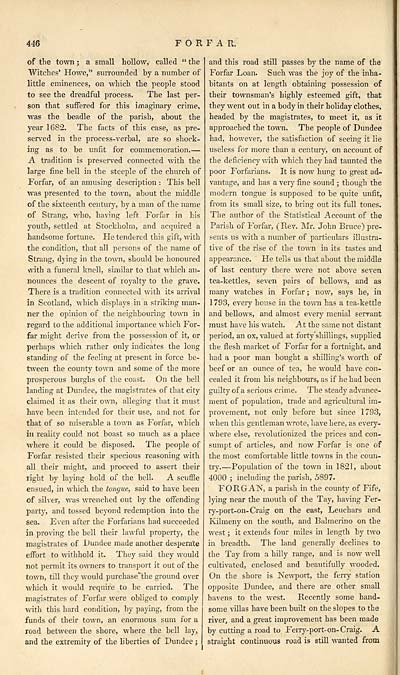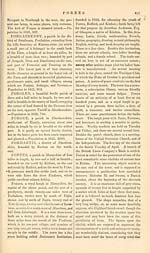Gazetteer of Scotland > Volume 1
(480) Page 446
Download files
Complete book:
Individual page:
Thumbnail gallery: Grid view | List view

446
FORFAR.
of the town ; a small hollow, called " the
Witches' Howe," surrounded by a number of
little eminences, on which the people stood
to see the dreadful process. The last per-
son that suffered for this imaginary crime,
was the beadle of the parish, about the
year 1682. The facts of this case, as pre-
served in the process-verbal, are so shock-
ing as to be unfit for commemoration
A tradition is preserved connected with the
large fine bell in the steeple of the church of
Forfar, of an amusing description : This bell
was presented to the town, about the middle
of the sixteenth century, by a man of the name
of Strang, who, having left Forfar in his
youth, settled at Stockholm, and acquired a
handsome fortune. He tendered this gift, with
the condition, that all persons of the name of
Strang, dying in the town, should be honoured
with a funeral knell, similar to that which an-
nounces the descent of royalty to the grave.
There is a tradition connected with its arrival
in Scotland, which displays in a striking man-
ner the opinion of the neighbouring town in
regard to the additional importance which For-
far might derive from the possession of it, or
perhaps which rather only indicates the long
standing of the feeling at present in force be-
tween the county town and some of the more
prosperous burghs of the coast. On the bell
landing at Dundee, the magistrates of that city
claimed it as their own, alleging that it must
have been intended for their use, and not for
that of so miserable a town as Forfar, which
in reality could not boast so much as a place
where it could be disposed. The people of
Forfar resisted their specious reasoning with
all their might, and proceed to assert their
right by laying hold of the bell. A scuffle
ensued, in which the tongue, said to have been
of silver, was wrenched out by the offending
party, and tossed beyond redemption into the
sea. Even after the Forfarians had succeeded
in proving the bell their lawful property, the
magistrates of Dundee made another desperate
effort to withhold it. Thoy said they would
not permit its owners to transport it out of the
town, till they would purchase'the ground over
which it would require to be carried. The
magistrates of Forfar were obliged to comply
with this hard condition, by paying, from the
funds of their town, an enormous sum for a
road between the shore, where the bell lay,
and the extremity of the liberties of Dundee ;
and this road still passes by the name of the
Forfar Loan. Such was the joy of the inha-
bitants on at length obtaining possession of
their townsman's highly esteemed gift, that
they went out in a body in their holiday clothes,
headed by the magistrates, to meet it, as it
approached the town. The people of Dundee
had, however, the satisfaction of seeing it lie
useless for more than a century, on account of
the deficiency with which they had taunted the
poor Forfarians. It is now hung to great ad-
vantage, and has a very fine sound ; though the
modern tongue is supposed to be quite unfit,
from its small size, to bring out its full tones.
The author of the Statistical Account of the
Parish of Forfar, ( Rev. Mr. John Bruce) pre-
sents us with a number of particulars illustra-
tive of the rise of the town in its tastes and
appearance. He tells us that about the middle
of last century there were not above seven
tea-kettles, seven pairs of bellows, and as
many watches in Forfar ; now, says he, in
1793, every house in the town has a tea-kettle
and bellows, and almost every menial servant
must have his watch. At the same not distant
period, an ox, valued at fortyshillings, supplied
the flesh market of Forfar for a fortnight, and
had a poor man bought a shilling's worth of
beef or an ounce of tea, he would have con-
cealed it from his neighbours, as if he had been
guilty of a serious crime. The steady advance-
ment of population, trade and agricultural im-
provement, not only before but since 1793,
when this gentleman wrote, have here, as every-
where else, revolutionized the prices and con-
sumpt of articles, and now Forfar is one of
the most comfortable little towns in the coun-
try. — Population of the town in 1821, about
4000 ; including the parish, 5897.
FORGAN, a parish in the county of Fife,
lying near the mouth of the Tay, having Fer-
ry-port-on- Craig on the east, Leuchars and
Kilmeny on the south, and Balmerino on the
west ; it extends four miles in length by two
in breadth. The land generally declines to
the Tay from a hilly range, and is now well
cultivated, enclosed and beautifully wooded.
On the shore is Newport, the ferry station
opposite Dundee, and there are other small
havens to the west. Recently some hand-
some villas have been built on the slopes to the
river, and a great improvement has been made
by cutting a road to Ferry-port-on- Craig. A
straight continuous road is still wanted from
FORFAR.
of the town ; a small hollow, called " the
Witches' Howe," surrounded by a number of
little eminences, on which the people stood
to see the dreadful process. The last per-
son that suffered for this imaginary crime,
was the beadle of the parish, about the
year 1682. The facts of this case, as pre-
served in the process-verbal, are so shock-
ing as to be unfit for commemoration
A tradition is preserved connected with the
large fine bell in the steeple of the church of
Forfar, of an amusing description : This bell
was presented to the town, about the middle
of the sixteenth century, by a man of the name
of Strang, who, having left Forfar in his
youth, settled at Stockholm, and acquired a
handsome fortune. He tendered this gift, with
the condition, that all persons of the name of
Strang, dying in the town, should be honoured
with a funeral knell, similar to that which an-
nounces the descent of royalty to the grave.
There is a tradition connected with its arrival
in Scotland, which displays in a striking man-
ner the opinion of the neighbouring town in
regard to the additional importance which For-
far might derive from the possession of it, or
perhaps which rather only indicates the long
standing of the feeling at present in force be-
tween the county town and some of the more
prosperous burghs of the coast. On the bell
landing at Dundee, the magistrates of that city
claimed it as their own, alleging that it must
have been intended for their use, and not for
that of so miserable a town as Forfar, which
in reality could not boast so much as a place
where it could be disposed. The people of
Forfar resisted their specious reasoning with
all their might, and proceed to assert their
right by laying hold of the bell. A scuffle
ensued, in which the tongue, said to have been
of silver, was wrenched out by the offending
party, and tossed beyond redemption into the
sea. Even after the Forfarians had succeeded
in proving the bell their lawful property, the
magistrates of Dundee made another desperate
effort to withhold it. Thoy said they would
not permit its owners to transport it out of the
town, till they would purchase'the ground over
which it would require to be carried. The
magistrates of Forfar were obliged to comply
with this hard condition, by paying, from the
funds of their town, an enormous sum for a
road between the shore, where the bell lay,
and the extremity of the liberties of Dundee ;
and this road still passes by the name of the
Forfar Loan. Such was the joy of the inha-
bitants on at length obtaining possession of
their townsman's highly esteemed gift, that
they went out in a body in their holiday clothes,
headed by the magistrates, to meet it, as it
approached the town. The people of Dundee
had, however, the satisfaction of seeing it lie
useless for more than a century, on account of
the deficiency with which they had taunted the
poor Forfarians. It is now hung to great ad-
vantage, and has a very fine sound ; though the
modern tongue is supposed to be quite unfit,
from its small size, to bring out its full tones.
The author of the Statistical Account of the
Parish of Forfar, ( Rev. Mr. John Bruce) pre-
sents us with a number of particulars illustra-
tive of the rise of the town in its tastes and
appearance. He tells us that about the middle
of last century there were not above seven
tea-kettles, seven pairs of bellows, and as
many watches in Forfar ; now, says he, in
1793, every house in the town has a tea-kettle
and bellows, and almost every menial servant
must have his watch. At the same not distant
period, an ox, valued at fortyshillings, supplied
the flesh market of Forfar for a fortnight, and
had a poor man bought a shilling's worth of
beef or an ounce of tea, he would have con-
cealed it from his neighbours, as if he had been
guilty of a serious crime. The steady advance-
ment of population, trade and agricultural im-
provement, not only before but since 1793,
when this gentleman wrote, have here, as every-
where else, revolutionized the prices and con-
sumpt of articles, and now Forfar is one of
the most comfortable little towns in the coun-
try. — Population of the town in 1821, about
4000 ; including the parish, 5897.
FORGAN, a parish in the county of Fife,
lying near the mouth of the Tay, having Fer-
ry-port-on- Craig on the east, Leuchars and
Kilmeny on the south, and Balmerino on the
west ; it extends four miles in length by two
in breadth. The land generally declines to
the Tay from a hilly range, and is now well
cultivated, enclosed and beautifully wooded.
On the shore is Newport, the ferry station
opposite Dundee, and there are other small
havens to the west. Recently some hand-
some villas have been built on the slopes to the
river, and a great improvement has been made
by cutting a road to Ferry-port-on- Craig. A
straight continuous road is still wanted from
Set display mode to: Large image | Transcription
Images and transcriptions on this page, including medium image downloads, may be used under the Creative Commons Attribution 4.0 International Licence unless otherwise stated. ![]()
| Gazetteers of Scotland, 1803-1901 > Gazetteer of Scotland > Volume 1 > (480) Page 446 |
|---|
| Permanent URL | https://digital.nls.uk/97430122 |
|---|
| Description | Volume I: Abbey to Glenartney. |
|---|---|
| Attribution and copyright: |
|
| Description | By Robert Chambers and William Chambers. Glasgow: Blackie & Son, 1838. 2 volumes. |
|---|---|
| Shelfmark | NF.1461.g.7 |
| Additional NLS resources: | |

